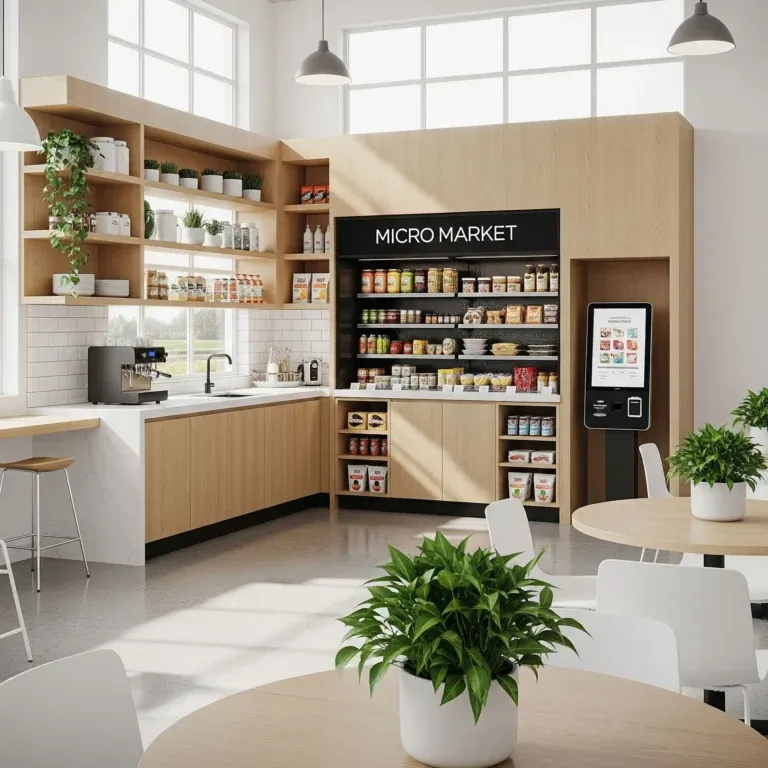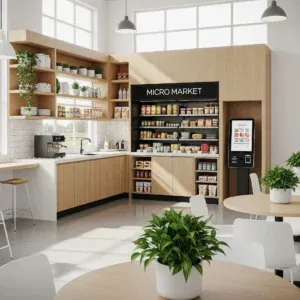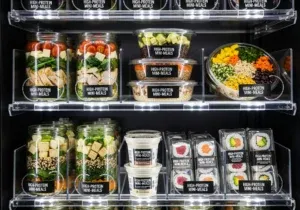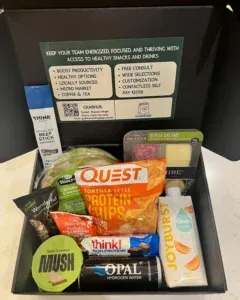Maricopa County Micro-Market Permits & Requirements
Who this is for: Facility managers, HR/EX leaders, office admins, and owners planning an unattended, self-checkout micro-market in the Phoenix metro.
This guide explains permits, fees, plan review, inspections, and equipment standards required by Maricopa County. We also compare micro-markets to vending and cafeterias so you can choose the right model for your workplace.
What counts as a micro-market in Maricopa County?
Maricopa County defines a micro-market as an unattended retail food establishment offering commercially prepackaged foods (including items that require refrigeration) to a defined group like employees inside a secured building area. The Environmental Health Code also caps the display area at 300 square feet and requires the market to be in a location where access can be limited to employees/customers of the business (MCEHC Ch. 8 §2, Reg. 6).
Tip: If your concept exceeds 300 sq. ft. of display area or is open to the general public, you may fall under a different retail/food establishment category. Confirm scope with the County early.
Permits & fees: what you’ll need in 2025
Micro-markets are not covered by a vending permit. Each location needs its own micro-market operating permit, and new operators must submit a one-time Reference Plan before opening sites. The County summarizes the process and fees in its official guidance:
- Reference Plan (one-time, master design): submit menu, finishes, mop/service sink location, 8.5×11 layout, NAMA/ANSI certification letter, and equipment spec sheets with auto-shutoff details (Micro-Market Guidance PDF).
- Operating Permit (per location): tied to the approved Reference Plan; permits are location-specific and not transferable (Minimum Requirements PDF).
- Fees (2025): Reference Plan $270, Operating Permit $155 per location per year, Processing Fee $20 per location (source and current fee schedule).
Applications and step-by-step instructions are available via the County’s New Application Guidance and the Micro-Markets & Vending page.
What to Expect: Timeline & Costs
A clean, predictable process from plan review to opening day.
-
1
Prep your Reference Plan
Assemble your menu, finishes, mop/service sink location, and an 8.5×11 scaled layout. Include ANSI/NSF/NAMA equipment cut sheets showing auto-shutoff controls for refrigerated units (County guidance).
-
2
County plan review
Environmental Services reviews the reference plan for code compliance, including ANSI-certified equipment, cleanable finishes, and mop/service sink details (Minimum Requirements).
-
3
Apply per location
For each site, submit an Operating Permit that references your approved plan. Note any minor site changes (e.g., mop sink location, extra cooler). Permits are location-specific and non-transferable.
-
4
Pre-opening inspection
The inspector verifies installed models, safe temperatures (≤ 41°F for cold foods), auto-shutoff functionality, labeling, and cleanliness. Post your permit conspicuously once approved (guidance).
Construction & equipment standards you must meet
- Mop/service sink on premises with hot/tempered water (100–110°F) and a mixing faucet/valve (Guidance; SPS: Mop Sink).
- Cleanable finishes: smooth, durable, easily cleanable floors/walls/ceilings where food is stored (Minimum Requirements).
- ANSI-certified commercial equipment (NSF/NAMA/ANSI) and model documentation (Minimum Requirements).
- Automatic shutoff / public health control on refrigerated units so access locks if temperature goes out of range (Guidance; MCEHC Reg. 6).
- Backflow protection as required (Minimum Requirements).
If you plan to add open food (e.g., made-to-order coffee with milk steaming), requirements change. Consult the County before adding equipment that introduces open food handling.
Operational rules (labels, temps, sourcing, inspections)
- Approved sources only: stock from licensed distributors/commissaries; no home-prepared foods (Guidance).
- Cold holding ≤ 41°F for TCS foods; verify with thermometers; discard if temps exceed safe limits (Guidance).
- Proper labeling on all prepackaged foods (name, ingredients, allergens, manufacturer info, dates) per FDA/County rules (Guidance).
- Permit posting: display your operating permit conspicuously at the market (Guidance).
- Renew annually and expect routine inspections. Maricopa uses FDA Food Code principles; see County’s food safety pages (Food & Restaurants).
State context: Arizona food safety rules align with the FDA Food Code; Maricopa County expressly references the 2013 FDA Food Code sections in its guidance (Guidance; ADHS Food Safety).
Micro-market vs. vending vs. cafeteria: compliance & workplace impact
All three require permits, but their operational burdens differ. Micro-markets deliver fresh variety and 24/7 access without on-site staff, often at $0 cost to the employer (the operator invests in equipment and recoups through sales). Cafeterias offer hot, made-to-order food but require costly build-out, staffing, and stricter kitchen standards.
| Aspect | Micro-Market | Vending Machines | On-Site Cafeteria |
|---|---|---|---|
| Permit type | Micro-Market (per location) | Vending Machine permit | Food service establishment |
| Staffing | Unattended; remote monitoring | Unattended | Staffed kitchen & service |
| Food range | Prepackaged incl. fresh & healthy | Primarily shelf-stable packaged | Made-to-order, hot meals |
| Space | ≤ 300 sq. ft display (MCEHC) | Minimal footprint | Kitchen + dining build-out |
| Employer cost | $0 typical (operator funded) | $0 typical | High capex + opex |
| Typical use | 50–500 employee offices | Small sites, narrow selection | Large campuses |
Regulatory references: MCEHC Ch. 8 §2 Reg. 6 (Micro-Markets), MCEHC Ch. 8 §4 (Vending).
Space, power & data checklist (practical setup)
- Footprint: plan the display area to remain ≤ 300 sq. ft (shelves, coolers, freezers, kiosk).
- Electrical: dedicated 120V circuits for coolers/freezers and kiosk (per manufacturer specs); avoid daisy-chains.
- Network: reliable ethernet or cellular for self-checkout and remote telemetry.
- Water & janitorial: access to a mop/service sink (often shared building janitorial room) with hot/tempered water.
- Security: 24/7 CCTV coverage of the market area; consider door-lock coolers for higher-value items.
Common mistakes (and easy wins)
- Missing auto-shutoff documentation: include cut sheets that specifically call out temperature lockouts—reviewers look for it.
- Unclear mop sink access: show the exact location on your 8.5×11 plan (on-premises). If shared, label the room.
- Consumer-grade fridges: use commercial ANSI/NSF/NAMA-listed units only.
- Permit posting: frame and mount near the kiosk on day one.
- Inventory sourcing: keep supplier/lot records; store off-site only in an approved, permitted facility.
Maricopa micro-market questions we hear most
Micro-markets sell only prepackaged foods, so no on-site food prep occurs. If your staff handles food while restocking, they should hold valid food handler cards consistent with County expectations. If your operator manages stocking (typical), they carry the required certifications.
Expect a pre-opening inspection and periodic routine inspections thereafter. The County follows FDA Food Code risk-based principles (see Food & Restaurants).
No. Off-site storage for market inventory must be an approved, permitted facility per County guidance (source).
Start with the County’s New Application Guidance and the dedicated Micro-Markets page.
Get compliant and launch smoothly
Want an expert to handle plan review, permitting, and setup? We design compliant layouts, supply ANSI-listed equipment, and stock fresh, healthy options—contract-free and typically at $0 cost to the employer.
How Micro-Markets Work See All Services Book a Site Assessment






